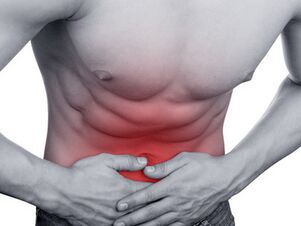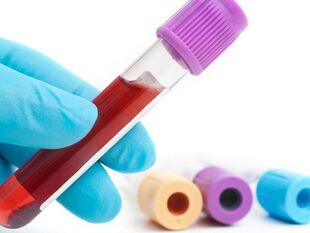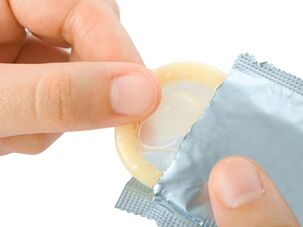Prostatitis refers to the pathology of the male purely urinary and reproductive systems. The disease can be acute or chronic, manifesting itself differently in each patient. Today is a common disease of the genitourinary system. By this time, the disease has become younger and is already occurring in men over 25 years of age. In this article, we will consider the question: how prostatitis manifests itself, and its treatment.

Required information
The nature of prostate dysfunction depends on the specific stage of sexual development in men:
- Damage to the prostate gland in adolescent men is possible. However, such diseases are not considered isolated diseases due to underdeveloped glands;
- men who have a violent sex life are more likely to have prostatitis in the form of acute inflammatory processes;
- Prostate disease in adult men manifests itself in one of three diseases: benign and malignant tumors, chronic prostatitis.
People who have undergone any type of reproductive organ removal do not have prostate function.
The prostate is the accessory gland of the reproductive apparatus on the strong part. It is located at the intersection of the urinary tract and the ejaculatory tunnel. The importance of the prostate gland in adolescent males before puberty has challenged research. In adults, the prostate is responsible for:
- secretion formation that makes semen less viscous and allows sperm to survive on the way to the egg;
- formation of prostaglandins in the body. This is the component responsible for increasing blood flow to the genitals before erection formation. It also stimulates the production of the hormone testosterone;
- is responsible for the high rate of semen production during ejaculation, and also participates in the last-minute appearance of sexual intercourse associated with the peak of intimate pleasure;
- with the help of reflexes does not allow the penetration of urine into the semen during intercourse.
The prostate gland is a poorly protected organ for pathogenic microbes. It directly depends on the pathological condition of the pelvic organs. Large blood and lymph flow, which travels through the damaged prostate canal, causes the phenomenon of stagnation and edema, thus exacerbating inflammation. The glands contain a large number of nerve fibers, so pathology is indicated by pain.

Prostatitis is an inflammatory damage to the prostate gland. The most common cause of the disease is pelvic infection. But the trapped infection itself is not capable of causing inflammation; this requires the presence of predisposing factors. This category includes:
- measured lifestyle (people with jobs are not at risk);
- regular stool retention;
- a lot of hypothermia;
- overly active intimacy and long confinement period;
The size of the prostate is small and weighs about 20-25 grams. But the secretion of the gland has the ability to adversely affect the microbes, therefore, inflammation in the prostate occurs during stagnation, then the secretion loses its bacterial properties.
Manifestations of prostatitis
There are two stages of the disease:
The acute form is indicated by the strongest inflammation of the prostate gland. Patients have a fever up to 39 degrees, there is pain in the groin area and in the process of excretion of feces and urine by the body. This is a hallmark of prostatitis.
In the chronic process, these symptoms can be resolved, therefore, many men do not pay attention to the special features of the disease. Patients may experience a temperature rise of up to 37 degrees, a painful sensation during defecation and defecation. However, the main symptom of chronic prostatitis is the removal of a small amount of mucus or purulent contents from the urethra.
Predisposing factors
There are the first 6 symptoms of prostatitis - this is a failure in the process of deurination due to the complicated production of urine from the bladder when the urethra is compressed by the enlarged prostate gland (dysuria syndrome):
- urinary excretion in stages;
- painful sensation;
- urine flow without pressure and not more than 20 cm;
- jet insecurity;
- urinate frequently at night;
- incomplete bladder emptying sensation.
Important! It is forbidden to diagnose prostatitis when these symptoms are detected without a thorough examination. The disease has a very complex initial process and development, which includes a variety of mechanisms.
Do not treat the disease only based on clinical manifestations. You should immediately contact a specialist for diagnosis and prescription of appropriate therapeutic measures. Diagnostics and therapy are prescribed taking into account the organs and systems affected by the disease. In some cases, you will need to see another specialist.
Signs of disease
Prostatitis can manifest as an acute form of inflammatory, and chronic process. The acute course is characterized by inflammation of the mucous membranes, follicles and parenchyma, however, they should not be confused with the symptoms of prostate adenoma. And chronic - indicated by concomitant diseases.
Symptoms of prostatitis in men, identified by clinical and functional examination:
- Frequent urination
A normal man may have a desire to urinate up to 12 times a day, usually 5 times. The volume of urine in healthy patients per day is from 1 to 2 liters. The desire to get rid of odors in healthy men arises when the bladder is filled with a volume of 120-170 ml. The accumulation of urine in excess of 350 ml gives rise to a strong desire to urinate.

In the inflammatory process, the walls of the bladder are systematically irritated and deodorized into:
- is uncommon, while the amount of urine is within normal limits;
- in small quantities: products of the inflammatory process irritate the bladder receptors, and there is a false desire to get rid of odors, the taste of the bladder is full, after emptying, a feeling of fullness remains;
- painful due to narrowing of the urethra;
- difficult due to urethral compression by glands, sometimes indicated by inability to empty the bladder during congestion;
- often at night;
- temperature.
Typically, temperatures rise from 37 to 38 degrees. In the early stages of sepsis with inflammation of the purulent glands, the temperature rises more than 39 degrees. In the last stage of septic shock, the temperature, on the other hand, drops to 35 degrees. Low temperatures pose a threat to human life due to platelet clotting disorders. Results in prostatitis with complications of sepsis are not good.
- Blood in the urine
This is relatively rare, but it is a sign of the dangers of the disease. Continuous bleeding is almost impossible to stop. There are several reasons for the development of hematuria:
- with perforated vessels into the urethra;
- trauma during research;
- malignant hyperplasia;
- pain.
Inflammation of the prostate with associated complications is accompanied by persistent pain. It can rarely intersect. Often, the pain is dull or aching and manifests itself in the perineum and anus.
Laboratory Methods
Appointed to explain the stage of the disease:
- Blood test. With the prostate, increased leukocyte content is detected, increased erythrocyte sedimentation rate and shift of leukocyte formula to stab cells;
- Urinalysis. Determine the purulent content in urine and the presence of bacteria. A study of 3 jars was used: 3 portions of urine were taken at the beginning, middle and end of deodorization. Numerous studies on urine at intervals of several days show changes in the bacterial flora;
- Bacteriological blood culture. It is prescribed to develop blood poisoning with daily temperature fluctuations of 3-5 degrees.

Instrumental research
- Ultrasound through the rectum. To clarify the diagnosis is the most informative method. This study has contraindications.
- X-ray method. Prior to examination, a contrast agent is injected into the bladder.
- Cutting of a piece of tissue for microscopic examination is used for limited indication.
Causes of prostatitis
Experts identify several classifications of why men can develop prostatitis:
- Complications of symptoms of a disease that befell a person before or the negative effects of gynecological diseases on a partner;
- urethral reflex. Prostate dysfunction is fraught with inability to stop the flow of urine. When this fluid reaches the genital tract, it is called the urethral reflex. After that, germination of glandular bacteria is formed. Such diseases are the result of inflammatory processes in the urethra or incorrect catheter insertion. There is also an expansion of the lumen of the urethra;
- unusual intimate lifestyle. If a man has a significant increase or decrease in the amount of sexual intercourse, this can contribute to the development of prostatitis. Persistent delays in ejaculation are also a concern;
- venous blood clots in the genitals in the pelvic area. This happens if the amount of movement is active, sports are not enough;
- hormonal disorders caused by low hormone production formed in the gonads. Due to this pathology, the general condition of skeletal and smooth muscles as well as other diseases occur.

Types of prostatitis
There are two parts to this disease: bacterial and non-bacterial.
The first type is characterized by the fact that the disease is caused by the presence of pathogenic microbes that have entered the body from the external environment. Staphylococci, streptococci, Escherichia coli and many more fall into the category of harmful microorganisms. In addition, this classification of prostatitis includes cases when the disease is caused by a disease transmitted through sexual intercourse.
For the second non-bacterial species, there are also several parts:
- Congestive prostatitis. In this case, glandular disease is caused by congestion in the pelvic area. These results are usually caused by incomplete ejaculation, too much intimate intercourse, abstinence, incomplete sexual intercourse.
- Sclerotic prostatitis. It is characterized by a decrease in the size and function of the prostate. There is thickening of the tissue membrane due to the death of prostate cells and its degeneration into hard connective tissue. The causes of this type are frequent bowel movements in the form of difficult and difficult bowel movements, taking certain medications and many infections. Inflammation of the prostate of this type is incurable.
- Prostatitis calculus. With this type of inflammation, the presence of stones in the glands is revealed. After reaching a large size, they cause severe pain in the urethra. Therapy consists of removing stones with surgical or therapeutic methods.
- Prostatodynia. It is characterized by the presence of persistent pain in the pelvic area, the cause of which has not been studied. It may be due to an outflow of secretions, bladder neck disease, damage to the muscle tissue between the anus and genital organs, and psychological factors may also occur.
- Prostatitis atypical. Patients may complain of pain in the lower leg, lumbar and sacrum, which are not present in the typical form of prostatitis. The outcome of therapy is directly related to the duration of the disease, the presence of complications and the severity of the inflammatory process.

If treatment is started at the wrong time, or there is an increase in recurrent prostatitis, the inflammation turns into a severe form, which is fraught with serious complications: decreased potency, inability to conceive, depression, severe pain, prostate adenoma in men.
Complications
Everything will directly depend on age, immunity, bad habits and timing of treatment. So, in the elderly with a low immune system, which is complicated by excessive consumption of products containing alcohol, the consequences will be very severe.
Actions against potential. Damaged glands reduce the production of hormones responsible for the onset of erection. Complications are lack of sensation fullness during intimacy, removal of weak semen, signs of prostate adenoma in men and impotence.
Influence of child conception. Inflammatory prostates reduce the production of normal secretions required for sperm activity in the female reproductive organs for fertilization. The secret is, entering the girl's birth canal during intimacy, undergoes immune rejection, which makes egg fertilization impossible.
Other complications. With increased prostatitis, the risk of pus accumulation in glandular tissue increases. Pain with prostatitis increases. When a secondary infection is attached, the epithelium leaks, followed by the appearance of a capsule adjacent to the inflammation. Also, the consequences include forms of urinary retention, urolithiasis, the appearance of prostate adenoma in men and others.
Intimacy with inflammation
It has been proven that the leading cause of prostatitis is lack of sexual intercourse with increased excitement or excessive sexual activity. Normal ejaculation with normal frequency has a good effect in the early stages of prostatitis. In some procedures and stages of the disease, it is temporarily forbidden to have intimate intercourse. More detailed information can be obtained through consultation with an expert.
Important! During the treatment of prostatitis, you can make love, but only with safety and simplicity in contact, unless determined by a doctor.
Prostatitis is a male-only disease. But inflammation of the glands poses a health risk to the couple. This poses a threat to conception and childbirth. A healthy lifestyle and reliable contraception are effective ways to protect couples from complications.

Prostatitis Treatment
It is possible to fully recover and stop the progression of the disease just by referring to a specialist. In this case, you will achieve a positive result. When irreversible changes appear, it is not possible to completely get rid of the disease. As a rule, recurrent inflammation occurs with a transition to the chronic type.
Along with drug treatment, one important thing is whether the patient is willing to change his lifestyle (for example, an irregular intimate relationship or an inactive lifestyle). If the patient does not want to change his normal way of life, then soon the disease will be felt again. Precisely with the fact that the patient does not want to change these negative factors, and the concept that prostatitis cannot be treated is connected.
Treatment options, duration will be determined by the specialist after a full examination and determination of the cause. Antibiotics are the main drugs used during treatment. Vitamins, physiotherapy, analgesic and anti-inflammatory medications are also recommended. The worsening of prostatitis requires a longer duration of treatment.
Diet
With proper diet and consumption of certain foods, you can achieve:
- reduces pain;
- increases the movement of blood and lymph in the prostate canal;
- boosts the immune system;
- normalization of bowel function;
- reduction of urine output at night.
The following foods should be excluded from the diet:
- Coffee and spicy foods - increase blood flow to the prostate, increase pain.
- Fats, fatty meats, eggs, flour products - increase the formation of cholesterol plaques on the walls of blood vessels, reduce the movement of blood flow.
- Alcohol products - lower the body's immune system.
- Foods with coarse and salty fiber - violates the shrinkage of non-corrugated intestinal wall.
- Excessive fluid intake (especially in the evening) - increases the fluid content in the body, which causes swelling.
Recommended foods: fresh vegetable salad with olive oil, fruits, boiled lean meats, vegetables, juices and nuts.

Prevention
Recommended:
- walking walking with wide steps (walking physiologically)
- rational nutrition;
- healthy lifestyle;
- use of male contraceptives;
- simple intimacy and more.
Conclusion
No need to wait for the disease to appear, but need to see a doctor once a year for preventive purposes. Treatment for the exacerbation of secondary prostatitis is much more difficult and requires a longer duration, and is also fraught with its own complications.
In this article, we learn how inflammation of the prostate gland manifests itself, and what is painful with prostatitis, how to treat this disease.
























